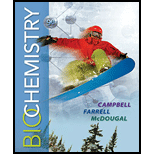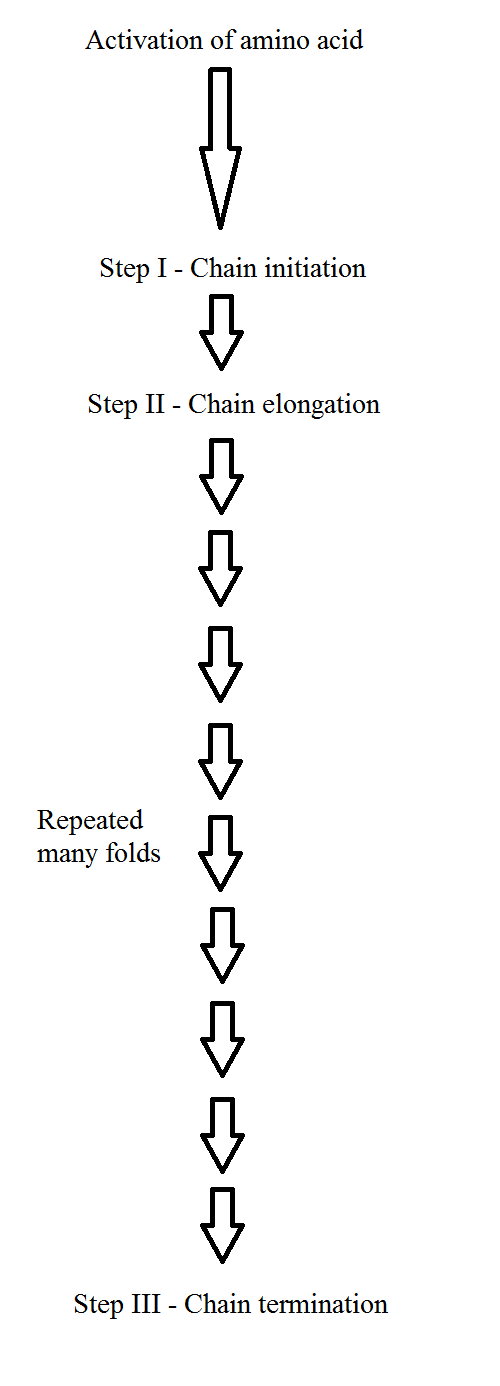
Concept explainers
RECALL Prepare a flow chart showing the stages of protein synthesis.
Interpretation:
A flow chart representing various stages of protein biosynthesis is to be prepared.
Concept introduction:
Proteins are large macromolecules, which consist of long sequences of amino acid residues. They are involved in a number of different biochemical processes in an organism.
They mostly differ in their structure and activity due to the arrangement of amino acid residues that is governed by their gene makeup.
Answer to Problem 1RE
Solution:

Explanation of Solution
Biosynthesis of protein is a complicated process that requires messenger and transfer RNA (mRNA and tRNA), ribosomes, and various protein factors. Ribosomes are the primary location for the biosynthesis of protein, to which the mRNA and tRNA are attached. The mRNA and tRNA are crucial for the correct arrangement of amino acids in the elongating chain.
The amino acid must be activated prior to being incorporated in the protein chain. The activation of amino acids requires tRNA and aminoacyl-tRNA synthetases (a group of specific enzymes). The amino acid residues get attached covalently to the tRNA forming aminoacyl-tRNA. The actual synthesis of polypeptide sequences takes place in three steps (chain initiation, chain elongation, and chain termination).
In the chain initiation step, the primary aminoacyl-tRNA gets attached to mRNA at a point that codes the initiation of polypeptide biosynthesis. The mRNA is attached with the ribosome, forming a complex. The subsequent aminoacyl-tRNA then makes a complex with the complex of ribosome and mRNA. The binding position for the subsequent aminoacyl-tRNA is adjacent to the primary aminoacyl-tRNA. Now, in the chain elongation step, formation of a peptide bond takes place between the amino acids. This process recurs until the polypeptide chain is accomplished. At last, in the chain termination step, the newly synthesized protein is released from the ribosomes.
The protein molecules are long chains of amino acids, the information for which is stored in the genetic code.
Want to see more full solutions like this?
Chapter 12 Solutions
Biochemistry
- REFLECT AND APPLY E. coli incorporates deoxyribonucleotides into DNA at a rate of 250 to 1000 bases per second. Using the higher value, translate this into typing speed in words per minute. (Assume five characters per word, using the typing analogy from Question 36.)arrow_forwardREFLECT AND APPLY Is the following statement true or false? Why? The flow of genetic information in the cell is always DNARNAprotein.arrow_forwardREFLECT AND APPLY Would you expect mRNA or rRNA to be degraded more quickly in the cell? Why?arrow_forward
- REFLECT AND APPLY Outline the methods you would use to pro- duce human growth hormone (a substance used in the treatment of dwarfism) in bacteria.arrow_forwardREFLECT AND APPLY Explain why a 50S ribosomal subunit and a 30S ribosomal subunit combine to form a 70S subunit, instead of an 80S subunit.arrow_forwardREFLECT AND APPLY The fidelity of protein synthesis is assured twice during protein synthesis. How and when?arrow_forward
- RECALL Define the term reducing sugar.arrow_forwardREFLECT AND APPLY What is the energy cost per amino acid in prokaryotic protein synthesis? Relate this to low entropy.arrow_forwardREFLECT AND APPLY Comment on the energetics of protein folding in light of the information in this chapter.arrow_forward
- REFLECT AND APPLY Suppose that you are a prosecuting attorney. How has the introduction of the polymerase chain reaction changed your job?arrow_forwardREFLECT AND APPLY The amino acid hydroxyproline is found in collagen. There is no codon for hydroxyproline. Explain the occurrence of this amino acid in a common protein.arrow_forwardREFLECT AND APPLY A biochemistry student characterizes the process of cooking meat as an exercise in denaturing proteins. Comment on the validity of this remark.arrow_forward
 BiochemistryBiochemistryISBN:9781305961135Author:Mary K. Campbell, Shawn O. Farrell, Owen M. McDougalPublisher:Cengage Learning
BiochemistryBiochemistryISBN:9781305961135Author:Mary K. Campbell, Shawn O. Farrell, Owen M. McDougalPublisher:Cengage Learning
